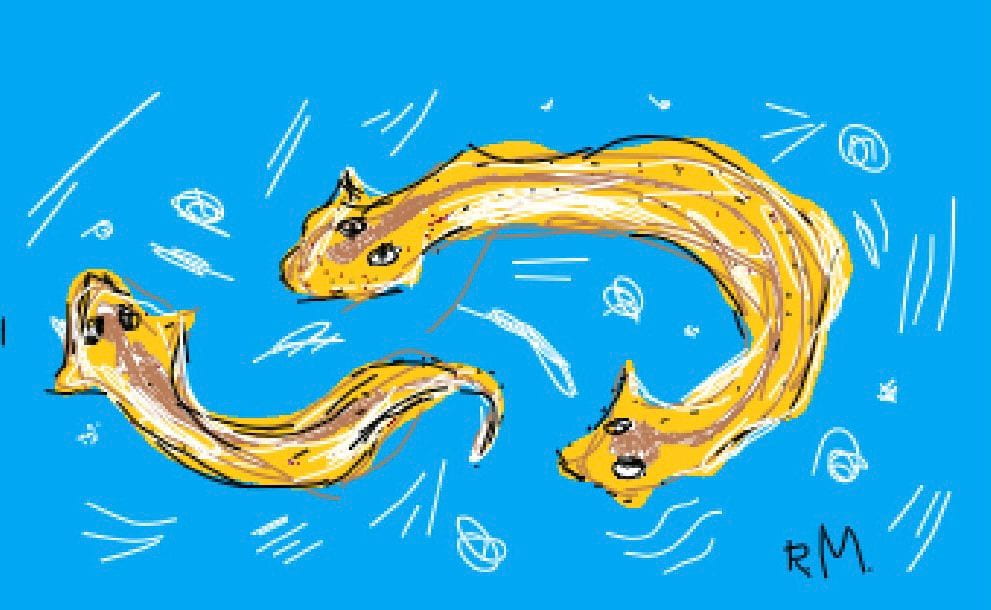By Reem Walid Malaeb | Staff Writer
The planarian is nobody’s idea of a genius. A flatworm shaped like a comma, it can be found lurking around lakes and ponds worldwide. Its pin-size head has a microscopic place for a brain. Its two eyespots are close together with strabismus that makes it always look cartoonishly confused. It wishes for nothing more than life as a bottom-feeder.
Yet the worm has dazzled the scientific community by mastering one task: perfect regeneration! Cut it in half, and the head will grow a new tail while the tail grows a new head. After just one week, two healthy worms wriggle away. What is unique about planarians, though, especially for their small size and regenerative abilities, is that they have a centralized nervous system: a head and brain. Those of you, philosophy enthusiasts, might ask: Is a regrown planarian still the same planarian? Does it still have the same memories? Indeed, the Tufts University biologist Michael Levin, demonstrated in a follow-up to the classical conditioning study that, yes, a planarian that loses its head retains its learning. His research led him to suspect that the intelligence of living things lies outside their brains to a surprising degree.
In their natural state, planaria prefer smooth to rough habitats. Put them in a dish with a ridged center, and they will cluster against the rim. But in his laboratory, about a decade ago, Levin trained some planaria to anticipate liver Puree droplets in the middle of a corrugated dish. They all soon ditched the fear of the rough surface, eagerly crossing the divide to get the treats. He also conducted other experiments with other planaria but in smooth dishes. Then he decapitated them all.
Levin discarded the head ends and patiently waited two weeks while the tail ends regrew new heads. After that, he placed the regenerated worms in ridged dishes and dripped liver into the center. Strange enough, worms that had lived in smooth dishes in their previous incarnation were reluctant to move, but worms regenerated from tails that had lived in rough dishes learned to go for food more quickly. Remarkably, despite the total loss of the brain, those planaria managed to retain the memory of the liver reward. The question remains, how are they able to do that?
It turns out that regular cells – not just neurons – can store information and act on it. Levin’s recent findings indicate that cells achieve this through subtle alterations in electric fields as a form of memory. These discoveries have positioned the biologist at the forefront of a burgeoning discipline known as basal cognition. In this emerging field, researchers have identified signs of intelligence—such as learning, memory, and problem-solving—both within and outside of the brain.
Until recently, most scientists held that true cognition arrived with the first brains half a billion years ago. Behavior was merely a kind of reflex, without intricate clusters of neurons. But Levin and several other researchers believe otherwise. He doesn’t deny that brains are awesome, paragons of computational speed and power. But he sees the differences between cell clumps and brains as ones of degree, not kind. In fact, Levin opts that cognition probably evolved as cells started to collaborate to carry out the incredibly difficult task of building complex organisms and then got souped up into brains to allow animals to move and think faster.
These findings arrived just in time with Elon Musk’s announcement of the first brain implant chip in humans. Xylene has been found to be improperly packaged in the Neuralink device, leaving us to ponder whether inserting hazardous material into the brain is truly an effective route since it can cause headaches, dizziness, confusion, loss of muscle coordination, and death. So, we ask ourselves, will Levin’s findings give us another way out? Can regenerative medicine be the key to instigating sensory and motor neuron loss? How much more can we learn about Planarians’ regenerative pathways? And how much of this knowledge can be applied to humans? The answer is: we don’t know yet!
References
https://www.scientificamerican.com/article/brains-are-not-required-when-it-comes-to-thinking-and-solving-problems-simple-cells-can-do-it/
https://www.psychologytoday.com/us/blog/natured-nurture/202210/is-memory-transfer-possible
https://www.theguardian.com/technology/2024/jan/29/elon-musk-neuralink-first-human-brain-chip-implant


This is a very eye-opening research topic that prompts reflection. Thoroughly enjoyed it!
“I enjoyed reading this! Keep up the great work.” http://www.5starsstocks.com/
I really appreciate your efforts. I enjoyed reading this.. Human to Pet Dog Voice Translation